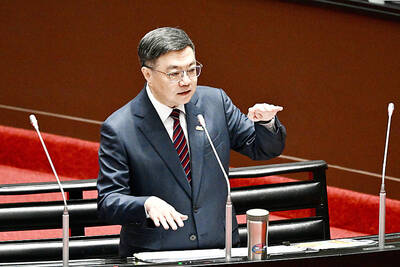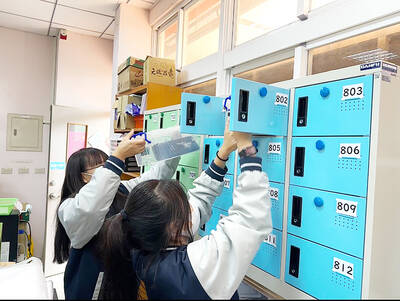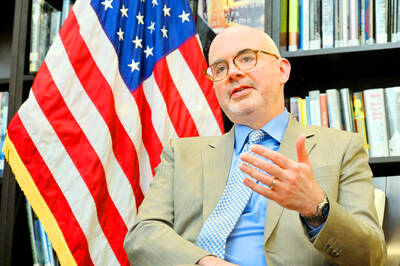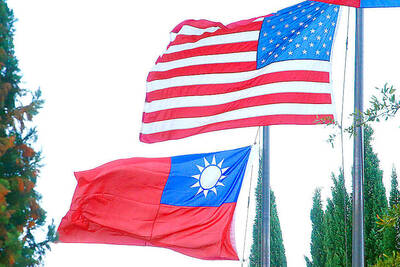North Korea yesterday conducted its first intercontinental ballistic missile (ICBM) launch in a month, possibly testing a new type of more mobile, harder-to-detect weapons system, its neighbors said, in an extension of Pyongyang’s provocative run of missile tests.
The launch prompted Japan to issue an evacuation order for Hokkaido, and although it was later retracted, it shows the vigilance of North Korea’s neighbors over its evolving missile threats.
The South Korean Joint Chiefs of Staff said the missile was launched on a high angle from near Pyongyang and fell in the waters between the Korean Peninsula and Japan following a 1,000km flight.

Photo: AFP
The Joint Chiefs of Staff described the missile as having a medium or longer range.
The US National Security Council called it a long-range missile, while the Japanese Ministry of Defense called it an ICBM-class weapon.
The South Korean military believes Pyongyang launched a new type of ballistic missile, possibly using solid fuel, a defense official said, speaking on condition of anonymity because of office rules.
If the launch involved a solid-fuel ICBM, it would be the North’s first test of such a weapon.
North Korea’s known ICBMs all use liquid propellant systems that require them to be fueled before launches.
However, the fuel in a solid-propellant weapon is already loaded inside, allowing them to be moved more easily and fired more quickly.
A solid-propellant ICBM is one of the key high-tech weapons that North Korean leader Kim Jong-un has vowed to build to better cope with what he calls US military threats.
Other weapons he wants to acquire are a multiwarhead missile, a nuclear-powered submarine, a hypersonic missile and a spy satellite.
Kim Dong-yub, a professor at the University of North Korean Studies in Seoul, said the launch might have involved a new intermediate or long-range missile powered by solid propellants, or be linked to North Korean preparation to launch a spy satellite.
US National Security Council spokeswoman Adrienne Watson said the latest launch “needlessly raises tensions and risks destabilizing the security situation in the region.”
Watson said the US would take all necessary measures to ensure the security of the US, and South Korean and Japanese allies.
During an emergency South Korean National Security Council meeting, officials condemned the launch and stressed the need to tighten three-way security cooperation with Washington and Tokyo.
Japanese Prime Minister Fumio Kishida held a Japanese National Security Council meeting to analyze the missile, as well as Japan’s response to it.
The top nuclear envoys of Seoul, Washington and Tokyo held a telephone conversation where they called for a “decisive and united international response” to North Korean provocations and stronger efforts to stem illicit North Korean activities that allegedly fund its weapons program.

NATIONAL SECURITY: The Chinese influencer shared multiple videos on social media in which she claimed Taiwan is a part of China and supported its annexation Freedom of speech does not allow comments by Chinese residents in Taiwan that compromise national security or social stability, the nation’s top officials said yesterday, after the National Immigration Agency (NIA) revoked the residency permit of a Chinese influencer who published videos advocating China annexing Taiwan by force. Taiwan welcomes all foreigners to settle here and make families so long as they “love the land and people of Taiwan,” Premier Cho Jung-tai (卓榮泰) told lawmakers during a plenary session at the Legislative Yuan in Taipei. The public power of the government must be asserted when necessary and the Ministry of

Proposed amendments would forbid the use of all personal electronic devices during school hours in high schools and below, starting from the next school year in August, the Ministry of Education said on Monday. The Regulations on the Use of Mobile Devices at Educational Facilities up to High Schools (高級中等以下學校校園行動載具使用原則) state that mobile devices — defined as mobile phones, laptops, tablets, smartwatches or other wearables — should be turned off at school. The changes would stipulate that use of such devices during class is forbidden, and the devices should be handed to a teacher or the school for safekeeping. The amendments also say

CONSISTENT COMMITMENT: The American Institute in Taiwan director said that the US would expand investment and trade relationships to make both nations more prosperous The US would not abandon its commitment to Taiwan, and would make Taiwan safer, stronger and more prosperous, American Institute in Taiwan Director Raymond Greene said. “The US’ commitment to Taiwan has been consistent over many administrations and over many years, and we will not abandon our commitment to Taiwan, including our opposition to any attempt to use force or coercion to change Taiwan’s status,” he said in an exclusive interview with the Liberty Times (the sister newspaper of the Taipei Times) on Friday last week, which was published in the Chinese-language newspaper yesterday. The US would double down on its efforts

EMBRACING TAIWAN: US lawmakers have introduced an act aiming to replace the use of ‘Chinese Taipei’ with ‘Taiwan’ across all Washington’s federal agencies A group of US House of Representatives lawmakers has introduced legislation to replace the term “Chinese Taipei” with “Taiwan” across all federal agencies. US Representative Byron Donalds announced the introduction of the “America supports Taiwan act,” which would mandate federal agencies adopt “Taiwan” in place of “Chinese Taipei,” a news release on his page on the US House of Representatives’ Web site said. US representatives Mike Collins, Barry Moore and Tom Tiffany are cosponsors of the legislation, US political newspaper The Hill reported yesterday. “The legislation is a push to normalize the position of Taiwan as an autonomous country, although the official US